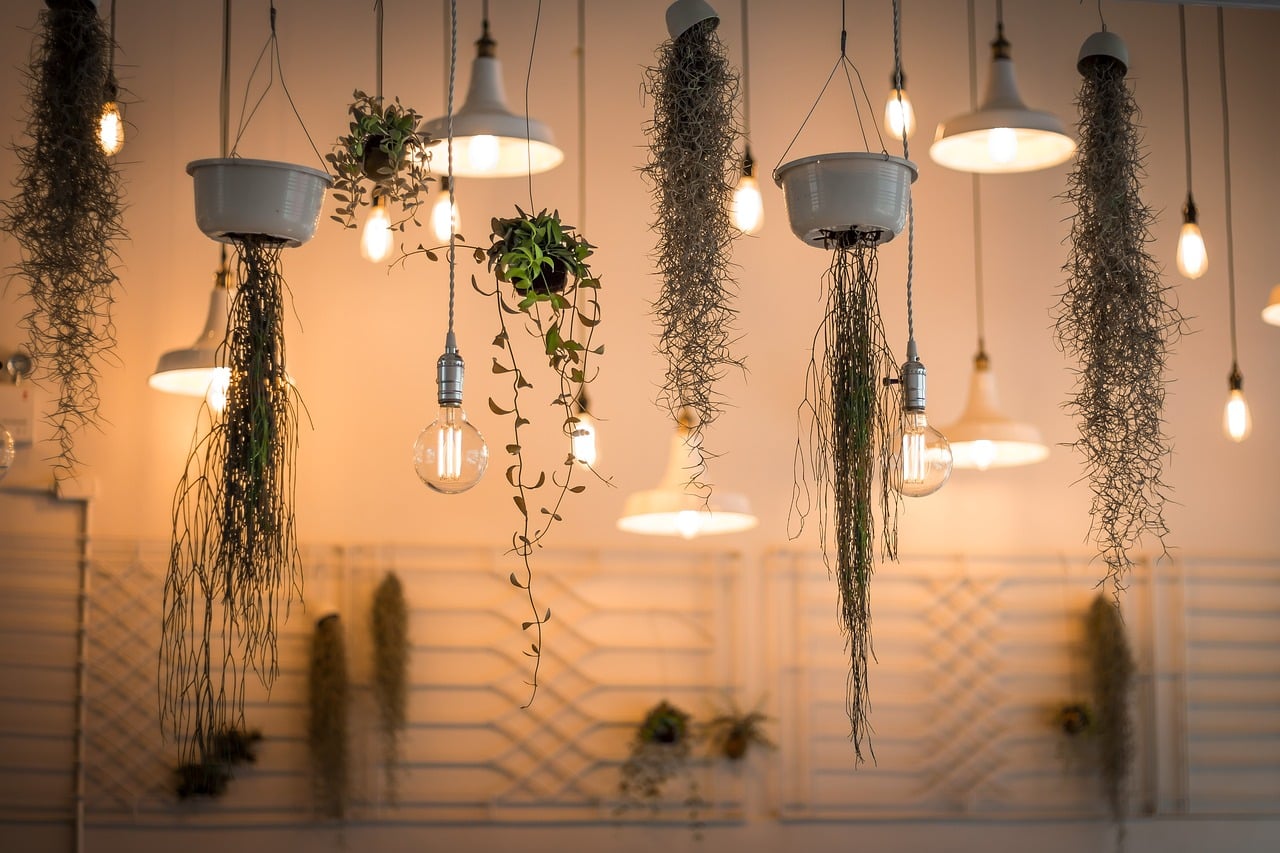Are you looking to add some greenery to your home, but don’t want the hassle of too much upkeep? Have you considered indoor hanging plants? They’re easy to care for and can turn any room into a lush, vibrant oasis.
If you’ve been considering getting some indoor hanging plants for your home but don’t know where to start, have no fear! We’ve done the research and have put together a list of the 9 best indoor hanging plants that are easy to care for, too.
From ferns and ivy to philodendrons and spider plants, there is something for everyone on this list. So whether you’re looking for a pop of green in your bedroom or want a low-maintenance addition to your living room, read on and find out which indoor hanging plant will suit your style and needs!
Types Of Easy To Care For Indoor Hanging Plants
When it comes to choosing plants for your home, hanging plants may be a great option. Not only do they look beautiful and add dimension to your home, but they can also be surprisingly easy to care for. Here are some of the best indoor hanging plants that are perfect for any home.
First, spider plants are one of the easiest houseplants around. They’re low light tolerant and can survive in a wide range of temperatures. Plus, they don’t need much water—just mist them every few weeks and let their soil dry out between waterings.
Second, many varieties of string-of-pearls thrive indoors as long as you give them plenty of bright light and keep their soil lightly moist at all times. They look lovely cascading from shelves or hanging baskets, and their unique round leaves make an eye-catching addition to any room.
Finally, pothos is another popular choice for indoor hanging plants since it’s incredibly hardy and can tolerate both low light and low humidity levels. It grows quickly with regular watering and occasional pruning—so it’s a great option if you want a lush foliage display without having to fuss over it too much.
These are just a few examples of easy-to-care-for indoor hanging plants that are sure to bring life into any space in your home. Next up, let’s take a look at the benefits of adding these kinds of plants to your living environment!
Benefits Of Hanging Plants In Your Home
The benefits of hanging plants in your home are numerous. Not only do they liven up any space, but they can also improve air quality and reduce stress levels. Here are the four key advantages to having these indoor plants:
First of all, hanging plants add an element of beauty to any area. They bring life and vibrancy to a room, as well as texture and color. Plus, with their trailing tendrils, they create a stunning visual effect that’s sure to grab attention.
Second, these plants have great air-purifying properties. They can help filter out toxins from the air, making it healthier for you and your family to breathe. What’s more, certain species like ivy or spider plants even work to reduce airborne allergens like dust or mold spores.
Thirdly, caring for these plants is relatively easy compared to other types of houseplants. All they need is some indirect light, occasional watering and a little TLC every now and then. This makes them perfect for busy people who don’t have time for complicated gardening tasks!
Finally, having indoor hanging plants around has been linked with lowered stress levels and improved mental health. Studies show that interacting with nature can be incredibly calming, making this type of greenery ideal for those struggling with anxiety or depression.
Hanging plants give us so many wonderful benefits – it’s no wonder why they’re such a popular choice! Now that you know why it makes sense to have them in your home, let’s take a look at how to choose the best one for you.
How To Choose The Best Indoor Hanging Plant
When most people think of hanging plants, they might recall the iconic macramé planters of the 70s. But these days, modern indoor hanging plants offer a contemporary, eco-friendly way to instantly add life and color to any room. By selecting the right indoor hanging plants for your home, you can reap a variety of benefits like improved air quality and a breath of freshness in any space.
Choosing an indoor hanging plant that’s easy to care for can be tricky. Luckily, there are plenty of options out there that don’t require much effort or time from you. To make sure you select the perfect one for your lifestyle, consider factors like light requirements, watering needs, and potential toxins emitted by the plant. For example, if you’re looking for an option that doesn’t need direct sunlight or frequent watering, a spider plant is an excellent choice since it thrives in indirect light and only needs water every three weeks or so.
In addition to selecting the right kind of indoor hanging plant for your home, it’s also important to make sure that you have all the necessary tools and supplies on hand before bringing one into your space. This includes items like potting soil suitable for container gardening, a spray bottle to mist your plants with water when needed, and protective gloves in case you’re dealing with spiny leaves or stems. With these items at your disposal and a little bit of patience on your part, caring for indoor hanging plants can be surprisingly easy – and incredibly rewarding!
Tools And Supplies Needed For Indoor Hanging Plant Care
Caring for your indoor hanging plants is just as important as learning how to choose them. You need the right tools and supplies for a successful job. This article will provide you with all the information you need to get started on caring for your new house plant.
Parallelism is key when it comes to caring for your indoor hanging plants. You’ll need soil, containers, fertilizer, watering cans or tubes, pruning shears and other trimming tools, hangers and hooks, and a bit of patience. All of these items are necessary to properly tend to your indoor hanging plants.
Having the proper supplies on hand will make it easier to keep your plants healthy and thriving in their new environment. Make sure you have plenty of water available so you can water them regularly, use fertilizer for added nutrients, and trim away any dead leaves or overgrown branches with pruning shears or other trimming tools. With these simple steps in mind, you’ll be well on your way to successfully caring for your indoor hanging plants! Next up: learning how to hang them in style!
How To Hang Indoor Hanging Plants
Hanging indoor plants can add a unique look to any space. In this section, we’ll explore how to hang these plants. Here are three tips for successful installation:
First, decide the best location for your new hanging plant. Consider if you want it near a window or in an area with natural light. Make sure there is enough space and that the plant won’t interfere with daily activities.
Second, gather the necessary materials for hanging your plant such as a pot hanger, screws, and nails. When selecting a pot hanger, choose one that is strong and able to hold the weight of your plant’s pot. Once everything is ready, use a leveler to ensure the pot hangs straight and securely attach it to the wall or ceiling.
Finally, when everything is securely hung, arrange your plant in its new home and make sure it looks balanced. With just a few simple steps, you’re all set for enjoying your indoor hanging plants!
Now that our plants are secured in place, let’s take a closer look at their light requirements.
Light Requirements For Indoor Hanging Plants
Stunning, lush, and vibrant hanging plants have never been easier to care for! With the right light requirements, you can create an indoor gardening oasis. Let’s take a deep dive into the light needs of some of the best indoor hanging plants.
To start, it’s important to remember that many of these plants enjoy bright but indirect lighting. In other words, not too much sun exposure is key. Here are some specifics:
- Ferns: These should be kept in medium or low light levels indoors.
- Succulents: These should be placed in bright areas with indirect sunlight.
- Philodendrons: These should be placed in medium to high light conditions.
These plants will all benefit from being near a window so they can soak up as much natural sunlight as possible while avoiding direct exposure that could lead to sunburns or wilting foliage. If you don’t have access to natural lighting, consider investing in fluorescent bulbs or LED lights that are specifically designed for growing houseplants – these can help provide the right amount of light your plant needs!
Water Requirements For Indoor Hanging Plants
As the old adage goes, you can’t have too much of a good thing. While it may be true for certain things in life, when it comes to watering indoor hanging plants, moderation is key. For people looking for easy-to-care-for plants that thrive indoors, understanding the water requirements of these plants is essential.
Watering an indoor hanging plant is a delicate balance between too little and too much. Too little water may result in wilting or brown leaves while overwatering can lead to root rot. To ensure optimal health, it’s important to check your plant’s soil moisture levels before doing anything else. Knowing which type of soil your plant prefers (e.g., clay-based mix or peat moss) will help you determine how often and how much water the plant needs.
When watering your indoor hanging plants, look out for signs that indicate your plant has received enough water such as droplets on the leaves or moistened roots. Depending on factors like temperature, light exposure and pot size, some plants might only need to be watered every couple of weeks while others require daily misting with a spray bottle. Regardless of your plant’s specific needs, it’s always important to err on the side of caution rather than overdoing it with the watering can – a little bit goes a long way! With this knowledge in hand, making sure your indoor hanging plants get just enough water should no longer be an issue.
The next step towards caring for their longevity and beauty? Fertilizer requirements – stay tuned!
Fertilizer Requirements For Indoor Hanging Plants
When it comes to caring for indoor hanging plants, fertilizing is an essential step. Just like humans need the right nutrition to stay healthy and thrive, plants need a balanced diet of nutrients to survive in their environment. A good analogy is that fertilizer is like the food for a plant – without it, they won’t have the energy to keep growing and flourishing.
As with anything in life, too much of a good thing can be bad for your plants. Over-fertilizing can be just as disastrous as not feeding them enough; both scenarios can cause stress on your plant’s system and lead to its death. That’s why it’s important to understand the best practices for fertilizer application and how often you should do it. Depending on the type of fertilizer you use, you may need to apply it more or less frequently than other types.
To get the most out of your fertilizer regimen, read up on when and how often you should feed each type of plant species in your collection. Additionally, many fertilizers come with instructions on how much and how often they should be applied – make sure to follow them closely! With proper care and attention, indoor hanging plants will look beautiful and stay healthy for years to come – no matter what kind of fertilizer you choose.
Common Indoor Hanging Plant Diseases And Pests
Just like our own bodies, plants can be susceptible to diseases and pests. From mildew to fungus, and from mites to aphids – it’s important to be aware of common indoor hanging plant diseases and pests. Like a guardian angel watching over their charges, know the symptoms and take steps in order to protect your plants!
The first symptom of an issue with one of your indoor hanging plants may be yellowing leaves or curled edges on the foliage. This could mean that they are being attacked by mites or aphids. The best way to treat these is by using an insecticidal soap. If you have a more serious pest problem, you may need to use a stronger chemical treatment for your plants.
In addition, there are some fungal diseases that can affect indoor hanging plants such as mildew or powdery mildew. To prevent this, it’s important to keep your plants in an area with good airflow and make sure they get enough sunlight during the day. Additionally, avoid overwatering your plants as this can lead to fungal growth. With proper care and attention, you can help ensure that your indoor hanging plant stays healthy and free from disease!
Luckily it doesn’t take much effort or knowledge to prune indoor hanging plants and keep them looking their best. Pruning helps promote healthy growth while also helping control the size of your plant so it fits better in your home!
How To Prune Indoor Hanging Plants
Pruning indoor hanging plants is an important part of keeping them healthy. In fact, according to research by the University of Florida, 94% of houseplants are pruned at least once a month. Pruning is essential for maintaining your indoor plants’ shape and size, controlling pests and diseases, and promoting growth. Here are five key tips to keep in mind when it comes to pruning your indoor hanging plants:
- Start with a pair of sharp scissors or pruners – dull blades can rip or tear leaves and stems, leaving your plants vulnerable to disease.
- Trim away dead or diseased branches first – this helps remove any potential sources of infection from the plant.
- Prune each stem one at a time – this allows you to control exactly how much you’re cutting off each stem.
- Avoid over-pruning – too much trimming can leave your plant looking sparse and unhealthy.
- Always wear gloves – this will help protect both you and the plant from any potential irritants or allergens that may be present on its leaves or stems.
By following these simple tips for pruning indoor hanging plants, you can ensure that they stay healthy and attractive for years to come! Next up we’ll cover some useful tips for keeping your indoor hanging plants healthy overall – not just through pruning!
Tips For Keeping Indoor Hanging Plants Healthy
Taking care of indoor hanging plants is a great way to add life and color to your home. But knowing how to keep them healthy is key. The good news is, there are some simple tips for keeping your plants in top condition.
One important thing to remember is that most indoor hanging plants need plenty of indirect light, but not too much direct sunlight. Be sure to check the instructions when you buy your plant, as different species may have different requirements. Also, make sure you’re watering your plant regularly – again, this will depend on the type of plant you have, but generally speaking it should be watered enough so that the soil remains moist but not soggy or wet.
Finally, it’s important to prune any dead leaves or stems off your plant every couple of weeks or so to encourage new growth and prevent disease from spreading. If you follow these steps and give your indoor hanging plants the right amount of care and attention they need, you’ll be rewarded with lots of vibrant foliage and beautiful blooms for years to come! With this knowledge in hand, let’s explore where we can find the perfect indoor hanging plants for our homes.
Best Places To Buy Indoor Hanging Plants
When it comes to bringing life into your home, nothing beats indoor hanging plants. They add vibrancy and texture to any space, while also being easy to care for. But before you can enjoy their beauty, you need to find the right ones! Here are the best places to buy indoor hanging plants:
• Garden Centers: Garden centers offer a wide variety of houseplants, including several types of indoor hanging plants. You’ll be able to see each plant in person so you can select the one that’s right for you. Plus, knowledgeable staff are available to help with any questions you may have about care and maintenance.
• Online Plant Stores: If you’re looking for more rare or unique indoor hanging plants, online stores are your best bet. You’ll be able to find a huge selection of houseplants from around the world without having to leave your home. Just make sure you research each plant carefully before making your purchase!
• Local Plant Markets: Local plant markets are great places to find a variety of different varieties of indoor hanging plants at reasonable prices. Plus, you’ll also get the opportunity to talk with experienced sellers who can offer advice on how best to care for your new plants.
No matter where you buy them, it’s important that you choose the right type of plant for your needs and give it proper care and attention so that it thrives indoors. With this in mind, you’re ready to start finding the perfect indoor hanging plant!
Different Ways To Display Indoor Hanging Plants
Displaying indoor hanging plants is an easy way to add a touch of nature to any room. With so many different ways to display them, there’s something that’ll work for any space. Whether you opt for the traditional macramé hangers or a modern, wall-mounted planter, you can easily find something that suits your style.
For starters, macramé hangers are a classic and timeless option that’s sure to bring in some extra bohemian vibes. They come in a variety of colors and styles, making it easy to match with existing décor. Plus, they’re great for displaying plants in corners or along walls where other options may not fit.
If you’re looking for something more modern or minimalistic, consider wall-mounted planters instead. These can be hung either inside or outside of your home and come in a range of shapes and sizes. You can even find ones with removable pots so you can switch out plants as needed without having to take the entire thing down each time.
With all these different options available, you can easily find the one that works best for your space – no matter what kind of look you’re going for!
Creative Ideas For Decorating With Indoor Hanging Plants
Adding a few indoor hanging plants to your home is an easy way to spruce up the decor. According to the National Gardening Association, houseplants can make us feel more relaxed and even increase productivity by 15 percent. With so many benefits associated with them, it’s no surprise that creative ideas for decorating with indoor hanging plants are in high demand.
One fun way to incorporate indoor hanging plants into your home decor is by creating a “living wall.” All you need is some macrame plant hangers and some small pots for each plant. Hang them in a pattern or any other design you’d like on a bare wall, and voilà – you have a living art piece in your home! Another great idea is using floating shelves as planters to display your indoor hanging plants. This decorative look allows you to show off multiple plants without taking up too much space.
You can also get creative with how you hang the plants themselves. Try mixing and matching various types of hangers, such as macrame, leather, metal, wood, etc., for an interesting aesthetic. If you’re feeling extra adventurous, try attaching plant hangers to the ceiling for a unique statement piece that will definitely turn heads!
By following these creative ideas for displaying indoor hanging plants in your home, you’ll be sure to bring some style and life into any room of your house. Now let’s look at troubleshooting tips for making sure they stay healthy and looking their best!
Troubleshooting Tips For Indoor Hanging Plants
Tending to plants can be a tricky task, especially when it comes to hanging ones. While they are certainly stunning decorations indoors, these suspended specimens require just as much attention and care as the ones kept on the ground. To ensure your hanging plants will thrive, here are some troubleshooting tips for indoor hanging plants.
First and foremost, be mindful of the environment. Most indoor hanging plants prefer bright indirect light but not too much direct sunlight, which can cause them to wilt quickly. Additionally, temperate climates and adequate ventilation are essential for their longevity—they need airflow in order to stay healthy.
Finally, water is key! As with other plants, you should water yours based on your specific species’ needs. Too little or too much H2O can both spell disaster for your greenery; so make sure you pay attention to how much water it’s getting and when it needs a refreshment. With these tips in mind, you’ll be able to keep your indoor hanging plants lush and alive for many months to come!
Frequently Asked Questions
What Is The Best Way To Hang An Indoor Hanging Plant?
The thought of hanging an indoor plant can be daunting. It’s like a glorified art project, with all the intricate details and potential for disaster. But with a few smart tips, it doesn’t have to feel like rocket science! To make the process easier and more enjoyable, here is the best way to hang an indoor hanging plant.
For starters, you’ll need to choose a spot in your home that gets enough indirect sunlight but also has enough room for your new friend to hang freely without obstruction. Once you’ve found the perfect spot, it’s time to get creative! Grab some rope or string, decorative planters and fillers (like rocks or moss), and finally – voila – your very own indoor jungle.
One of the best parts about hanging plants is that they are easy to care for – no need for green thumbs here! Just give them a good soak once a week and watch them thrive throughout the year. Here are three tips that will help your plants survive: • Regularly check for signs of pests or disease • Don’t water too much or too little • Make sure they’re in an area that gets enough indirect sunlight
Hanging plants are not only beautiful additions to any space, but they can also improve air quality and lift your mood when things seem gloomy. So don’t hesitate – start your own DIY project today and enjoy watching your new friends grow in their cozy homes!
How Often Should I Water My Indoor Hanging Plants?
Hanging plants bring life and vibrancy to any home, but it is important to remember that they require some extra care. Watering your indoor hanging plants often is the key to keeping them healthy and lush. But how often should you water them?
Watering indoor hanging plants can be tricky. To determine how much water is needed, you’ll need to assess the size of your indoor space and the type of plant. Generally speaking, most indoor hanging plants should receive a good soaking once a week. However, some may require more or less depending on their individual needs.
For optimal health and longevity, it’s best to check your hanging plants’ soil daily. If it feels dry to the touch, give them a few extra splashes of water. On the other hand, if the soil feels damp, then wait until it dries out before watering again. This will help ensure that your plant receives just enough moisture without becoming overwatered or soggy.
How Do I Know If My Indoor Hanging Plants Are Getting Enough Light?
Taking care of indoor plants can be tricky, especially when they hang from the ceiling. One of the most important aspects of caring for hanging plants is making sure they’re getting enough light. But how do you know if your plant is getting enough?
First, it’s important to note that different types of plants require different levels of light. For example, ferns and spider plants love bright, indirect sunlight while succulents and bromeliads thrive in low light conditions. That said, all hanging plants should have some direct sunlight each day. To test if your plant is getting enough direct sun, use a light meter or simply observe how the leaves look throughout the day – if the leaves look healthy and vibrant, it’s likely receiving adequate sunlight.
If your plant isn’t getting enough light, you may need to adjust its location or find a new spot for it altogether. Try rotating it occasionally so it receives an even amount of sun throughout the day and make sure any blinds or curtains are open during daylight hours. Additionally, artificial grow lights can be used to supplement natural sunlight in areas with insufficient lighting.
No matter which type of hanging plant you choose to bring into your home, proper lighting is essential for keeping them looking their best. With careful observation and some adjustments as needed, you’ll be able to ensure that your indoor hanging plants get just the right amount of light to thrive!
What Is The Best Way To Prevent Indoor Hanging Plant Diseases And Pests?
When caring for your indoor hanging plants, it’s important to know how to prevent diseases and pests. Otherwise, your beloved plant won’t be able to thrive and you won’t get the full benefits of having an indoor hanging plant. Fortunately, there are a few simple steps you can take to help protect your plants from diseases and pests.
The best way to protect your indoor hanging plants is by making sure they get enough light and are in the right temperature and humidity levels. If your plants aren’t getting enough light or if the environment isn’t suitable, they can become vulnerable to various diseases and pests. Make sure you place them in a spot where they will get plenty of light but also avoid any direct sunlight that could damage them. Additionally, ensure that the temperature and humidity levels are within an acceptable range for your specific type of plants so that they don’t become stressed out or susceptible to problems.
Another way of preventing indoor hanging plant diseases and pests is by regularly inspecting your plants for signs of damage or infestations. Look closely at the leaves, stems, roots, and soil for any signs of damage or discoloration. If you see anything unusual on your plants, take immediate action by either pruning off any affected parts or quarantining it until it recovers. Additionally, make sure to clean up any dead leaves or debris from the soil so that pests don’t have a hiding place in which to breed. By following these steps along with proper watering techniques and fertilization schedule, you will be able to keep your indoor hanging plants healthy and beautiful for many years!
What Type Of Fertilizer Should I Use For My Indoor Hanging Plants?
Aspiring gardeners everywhere are drawn to the beauty and ease of indoor hanging plants. But when it comes to caring for these lush additions, fertilizer is a critical factor. What type of fertilizer should one use for their indoor hanging plants?
To nurture these delicate blooms, gardeners need to feed their foliage with the correct nutrients. A quality all-purpose liquid fertilizer is key for keeping your plants healthy and happy. This type of plant food can be used every two weeks during spring and summer and monthly during fall and winter. Be sure to read the labels carefully as some fertilizers may be too strong for your specific plants, leading to burning or even death.
Organic fertilizers are also a great way to help your plants grow without the worry of overfeeding them with harsh chemicals. These organic alternatives often contain higher levels of nitrogen, phosphorus, and potassium than conventional fertilizers, which can help nourish your indoor hanging plants even further. With this in mind, it’s important to remember that organic options may not last as long as synthetic ones, so plan on replacing them more often than you would regular fertilizer.
Conclusion
In conclusion, indoor hanging plants are a great way to add a touch of life and greenery to any home. With the right care and attention, these plants can bring beauty and joy into your home for years! When it comes to caring for indoor hanging plants, there are several tips and tricks that can help ensure their success. Watering regularly and ensuring they get enough light are essential steps. Additionally, preventative measures such as proper fertilizer and pest control can help keep them healthy. With just a little bit of effort, you can create an oasis of lush indoor hanging plants that will be the envy of all your friends! Exaggerating just how impressive your collection will be is sure to make them even more jealous! Who knows? You may even inspire others to spruce up their homes with some gorgeous indoor hanging plants of their own.





























